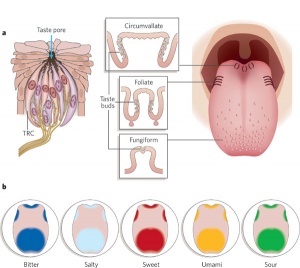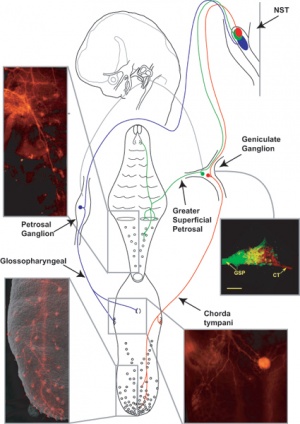Sensory - Taste Development
From Embryology
Introduction

Tongue taste map[1]

[http://embryology.med.unsw.edu.au/Notes/tongue.htm original page
Some Recent Findings
- "Mammalian taste buds have properties of both epithelial and neuronal cells, and are thus developmentally intriguing. Taste buds differentiate at birth within epithelial appendages, termed taste papillae, which arise at mid-gestation as epithelial thickenings or placodes. ...we demonstrate that Shh-expressing embryonic taste placodes are taste bud progenitors, which give rise to at least two different adult taste cell types, but do not contribute to taste papillae. Strikingly, placodally descendant taste cells disappear early in adult life."[3]
References
Reviews
Articles
Search PubMed
Search May 2010
- Taste System Development - All (320) Review (64) Free Full Text (78)
- Tongue Development - All (2804) Review (258) Free Full Text (519)
Search Pubmed: Taste System Development | Tongue Development
Glossary Links
- Glossary: A | B | C | D | E | F | G | H | I | J | K | L | M | N | O | P | Q | R | S | T | U | V | W | X | Y | Z | Numbers | Symbols | Term Link
Cite this page: Hill, M.A. (2024, April 27) Embryology Sensory - Taste Development. Retrieved from https://embryology.med.unsw.edu.au/embryology/index.php/Sensory_-_Taste_Development
- © Dr Mark Hill 2024, UNSW Embryology ISBN: 978 0 7334 2609 4 - UNSW CRICOS Provider Code No. 00098G